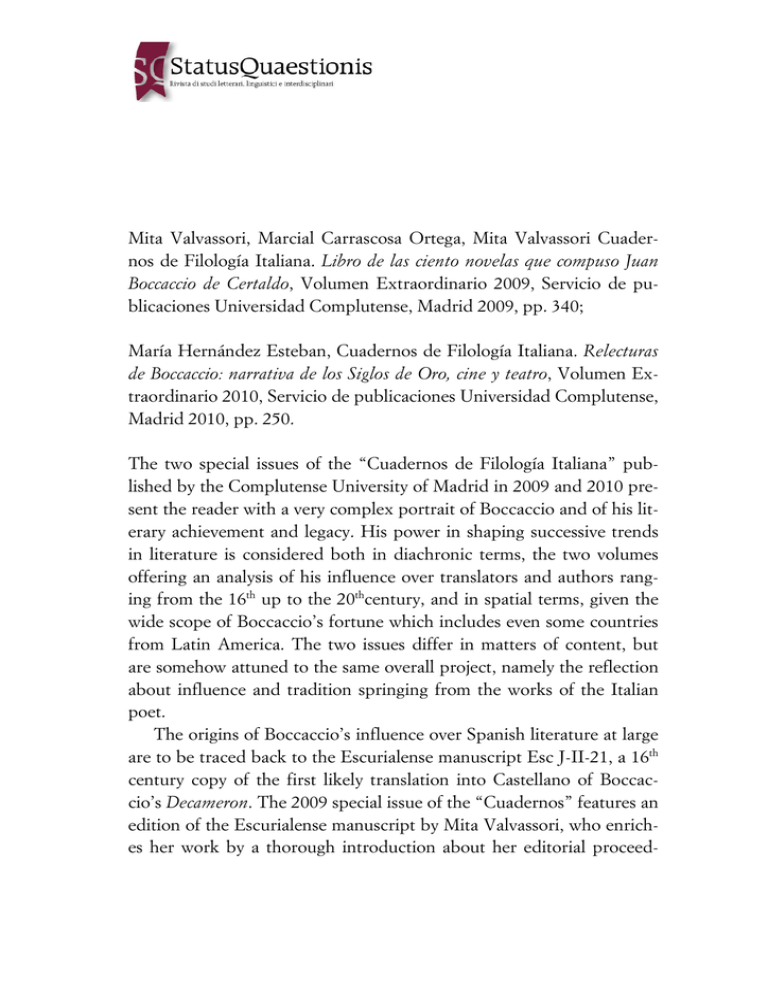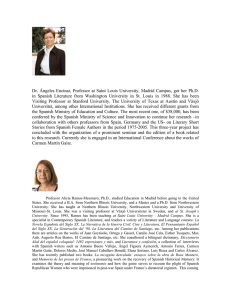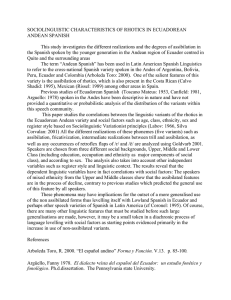this PDF file
Anuncio

Mita Valvassori, Marcial Carrascosa Ortega, Mita Valvassori Cuadernos de Filología Italiana. Libro de las ciento novelas que compuso Juan Boccaccio de Certaldo, Volumen Extraordinario 2009, Servicio de publicaciones Universidad Complutense, Madrid 2009, pp. 340; María Hernández Esteban, Cuadernos de Filología Italiana. Relecturas de Boccaccio: narrativa de los Siglos de Oro, cine y teatro, Volumen Extraordinario 2010, Servicio de publicaciones Universidad Complutense, Madrid 2010, pp. 250. The two special issues of the “Cuadernos de Filología Italiana” published by the Complutense University of Madrid in 2009 and 2010 present the reader with a very complex portrait of Boccaccio and of his literary achievement and legacy. His power in shaping successive trends in literature is considered both in diachronic terms, the two volumes offering an analysis of his influence over translators and authors ranging from the 16th up to the 20thcentury, and in spatial terms, given the wide scope of Boccaccio’s fortune which includes even some countries from Latin America. The two issues differ in matters of content, but are somehow attuned to the same overall project, namely the reflection about influence and tradition springing from the works of the Italian poet. The origins of Boccaccio’s influence over Spanish literature at large are to be traced back to the Escurialense manuscript Esc J-II-21, a 16th century copy of the first likely translation into Castellano of Boccaccio’s Decameron. The 2009 special issue of the “Cuadernos” features an edition of the Escurialense manuscript by Mita Valvassori, who enriches her work by a thorough introduction about her editorial proceed- Libro de las ciento novelas que compuso Juan Boccaccio de Certaldo. Relecturas de Boccaccio: narrativa de los Siglos de Oro, cine y teatro, SQ 3(2012) ings. The reader is provided with practical details about editorial choices such as the preserving of original punctuation, textual or copying errors, and about the editor’s direct interventions into the text itself. Despite the philologists’ traditional dismissal of the Escurialense manuscript for reasons of translational inaccuracy, Valvassori underlines the importance of such a text as shedding light on the new audience its translator had worked for. Therefore, rather than concentrating on the adherence of the text to the Boccaccian original, Valvassori’s edition must be considered as an invaluable tool to be used in order to better understand the target reader of this new text and the historical context he belonged to. Moreover, the editorial endeavor pays much attention to our contemporary readership: the text resulting from such an editorial approach is accessible to current readers while maintaining at the same time a strictly philological perspective. Finally, Valvassori’s introduction is followed by a table of contents displaying the correspondences between the original novelle and the translated episodes, the latter amounting to 50 in total. The concepts of tradition and transmission are at the core of the 2010 special issue of the “Cuadernos” too. This second volume features a number of essays about the influence of Boccaccio over authors ofSpanish and Italian cultures, who depart from the poet of Certaldo not only in terms of diachronic distance, but also in terms of artistic mediums each one of them respectively chooses. The image of Boccaccio we get from these writings is that of a powerful predecessor getting across time barriers, national and linguistic boundaries and semiotic domains. The volume is divided into three main sections, the first dealing with Boccaccio in Spanish literature, the second dealing with Pasolini’s cinematographic re-reading of the poet, and the last one focusing on the role of the Oranona theatre in Certaldo and of its staging of Boccaccio in contemporary Italy. 258 Valvassori’s essay (Observaciones sobre el estudio y la edición de la traducción castellana Antigua del Decameron) opens the first section of the issue by resuming the main ideas of her 2009 volume introduction: the true value of the manuscript lies in its bearing evidence of a fundamental contact between two different cultural entities. The two texts are not to be compared in terms of translating faithfulness, the second being judged according to its adherence to the source one. Boccaccio appears as the predecessor underlying the writings of numberless Spanish authors spanning from the 16th up to the 20th century, and the remaining essays of the first section follow exactly this strand of thought. While some of them focus on the connection between one among Boccaccio’s novelle and a precise literary work of Spanish background recovering it, others deal with a general theme or feature Spanish literature inherited from the writer of Certaldo. Among the essays belonging to the first category just mentioned, Vittoria Foti’s Relecturas del Decameron y del Amadís de Gaula en Matteo Bandello analyzes the convergence of Boccaccian elements of narration (particularly from Decameron II,9 and IV,1) with whole quotations from the Amadís de Gaula as shaping a particular novella by Matteo Bandello (I, 27). In this case, Boccaccio’s influence helps the 16th century Italian writer reframe the dynamics of chivalric romance into a background which consequently appears as more centered on the psychologies of its main characters. Dealing with the reworking of a particular novella by Boccaccio within the development of Spanish literature, David Caro Bragado’s essay (La comunicación entre los amantes por medio de involuntarios terceros: Decameron III, 3 y La discreta enamorada de Lope de Vega) focuses on the powerful influence of Boccaccian tradition getting across boundaries of genre. One of the greatest authors of the Spanish Siglo de Oro, Lope de Vega, drew from Boccaccio for at least eight of his plays. The play Caro Bragado analyzes, La discreta enamorada, shares both the overall setting and characters’ point of view as those of Boccaccio’s novella III,3, and especially the fundamental dramatic device 259 Libro de las ciento novelas que compuso Juan Boccaccio de Certaldo. Relecturas de Boccaccio: narrativa de los Siglos de Oro, cine y teatro, SQ 3(2012) of the communication through an inapt mediator (a priest in Boccaccio, and Fenisia’s father in Lope). Isabel Colón Calderón’s essay (Miedos infundados a lo sobrenatural: la narrativa hispánica de los Siglos de Oro y Valle Inclán ante II,5 del Decamerón) provides the reader with a wide literary panorama of Boccaccian influence over Spanish tradition, starting again from the 17th century: through a partial reorganization of narrative motifs, the influence of “Andreuccio da Perugia” tale (Decameron II,5) is traced in authors spanning from the Siglo de Oro, such as Suárez de Figueroa or Baltasar Gracián, up to Ramón María del Valle-Inclán’s short story, “El miedo”, published in 1902. The diachronic transmission of Boccaccian echoes is matched by a spatial and geographical spread, as José Manuel Pedrosa illustrates in his essay El hortelano en el jardín de las monjas: Boccaccio, Decamerón III,1: several elements from the story of Masetto among the nuns are to be traced along the tradition of 16th century canciones, 16th and 17th century romancero and in tales or cuentos of both Spanish and Latin American background, as the Colombian tale “Las monjas, el salsichón y el padre Juan” attests. Rather than following the development of a single Boccaccian novella by a Spanish successor, Asunción Rallo Gruss (La ficción como novella: Boccaccio en La vida del escudero Marcos de Obregón) explores the recovery of typically Boccaccian tools of narration in Vicente Espinel’s La vida del escudero Marcos de Obregón. Rallo Gruss goes through a detailed analysis of the three main narrative devices Espinel inherited from Boccaccio (by making particular reference to Decameron II,5 as his source) and which were meant to inspire both diversion and moral reflection to the reader: first of all the recurrence of urban realistic settings, allowing for a deeper sympathetic effect on the reader’s part; then the element of laughter as having a beneficial and curative effect; finally the crucial role of revulsion as an element of suspense. David González Ramírez focuses on Boccaccio and his realistic perspective on narration as representing one of the main conditions 260 leading to the rise of costumbrismo in Spanish literature (La disolución del marco narrativo en el orígen del costumbrismo. De la Guía y avisos de forasteros a los Días de fiesta de Zabaleta): evidence of such a connection is mainly traced in the device of the narrative frame as representing the first link between Spanish authors of the 17th century such as Castillo Solórzano or Remiro de Navarra and Boccaccio’s Decameron. Besides focusing on all the elements these authors inherited from the Italian master, like the novella narrative mold, the recurring use of the dialogic form, the realistic description of habits, González Ramírez also provides a detailed analysis of the Spanish works in terms of content, concentrating on the degree of originality and independence they increasingly gained with respect to such an illustrious predecessor. The second section of the volume presents the reader with an utterly different perspective on Boccaccio’s influence on modern art and culture, focusing on his 20th century legacy: Pasolini’s cinematographic reading of the Decameron confirms Boccaccio’s ability to get across time, space and semiotic barriers. Moreover, the Italian master proves to be much more than a mere pretext for an intersemiotic translation of his tales: filming the Decameron rather prompts Pasolini’s deep revision and reconsideration of all his theories of visual and cinematographic language, enhancing his commitment to very specific issues of semiotic and translational import. Maria Josefa Calvo Montoro traces in the Decameron Pasolini’s sheer poetic declaration, an endeavor eventually leading the director to adopt a much simpler language with respect to his previous movies (El Decameron de Pasolini como declaración de poética). Chiara Cappuccio’s essay (La musica del Decameron, tra Boccaccio e Pasolini) widens the intersemiotic scope of the whole section’s approach by concentrating on the soundtrack of the movie: relying on the importance Boccaccio attributed to the medium of music in his own literary work, Pasolini pays particular attention to the soundtrack and to the overall contrappunto effect that music and image have to produce on the audience in order to make them continually aware of a 261 Libro de las ciento novelas que compuso Juan Boccaccio de Certaldo. Relecturas de Boccaccio: narrativa de los Siglos de Oro, cine y teatro, SQ 3(2012) non-coincidence between different semiotics. Miguel Ángel Cuevas pursues the same line of thought of Cappuccio’s essay, including in his observations the medium of painting and its relevance for the Italian director (El Decameron de Pasolini: manipulación “de autor”): while deliberately emulating the spontaneity and genuineness of Giotto’s painting, Pasolini’s images are also the product of a precise reflection on the theories of Charles Sanders Peirce. Semiotic theories of translation and transmutation are also at the core of David Hidalgo Ramos’ essay, De Boccaccio a Pasolini: análisis comparativo de la adaptación de Pasolini del cuento IV, 5 del Decameron: reference is here made to authors such as Jakobson, Lotman, Saussure and Metz, all contributing to shape Pasolini’s personal conception of cinematographic language and his intersemiotic translation of Boccaccio’s Decameron. Carlo Romiti and Ilaria Landi’s essay, Come l’Oranona racconta Boccaccio. Lettura del Decameron e drammatizzazione delle novelle, covers the last section of the issue. An account of the Oranona theatre activities in Certaldo is here presented. The authors offer a detailed description of the readings of the Decameron taking place every second Friday of each month at the old Limonaia and of the theatre productions of the Oranona, turning Boccaccio’s novelle into plays that are performed in various locations of Certaldo. With its halls, squares and natural stages, the town itself is turned into a huge playhouse, offering the audience a fuller appreciation of Boccaccio’s original flavor. The sweeping literary panorama portrayed by the two volumes is thus multifaceted and enriching, especially if considered from a comparatistic perspective. Though offering such a complexity of views, the three main sections of the second volume may appear too loosely connected between them, without a strong backbone constituting the common ground of research for them all. However, it is right in the multiplicity of declinations Boccaccio’s influence ultimately proves to lead to that the richness of such an academic endeavor needs to be traced. The two issues of the Complutense University of Madrid are 262 the product of a comprehensive research project that proves ultimately invaluable on two different grounds: on the one hand, they give the reader a wide-ranging account of Boccaccian echoes and influences over Spanish literary tradition up to the 20th century; on the other hand, they open up new scholarly vistas on issues of intersemiotic translation and transmutation which will become crucial for the survival of Boccaccio in a culture where image and sound play an increasingly pivotal role. Chiara Moriconi “Sapienza” Università di Roma 263





